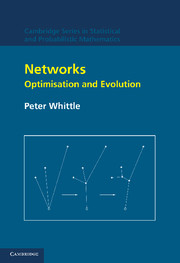Book contents
- Frontmatter
- Contents
- Acknowledgements
- Conventions on notation
- Tour d'Horizon
- Part I Distributional networks
- Part II Artificial neural networks
- Part III Processing networks
- 13 Queueing networks
- 14 Time-sharing processor networks
- Part IV Communication networks
- Appendix 1 Spatial integrals for the telephone problem
- Appendix 2 Bandit and tax processes
- Appendix 3 Random graphs and polymer models
- References
- Index
14 - Time-sharing processor networks
Published online by Cambridge University Press: 23 November 2009
- Frontmatter
- Contents
- Acknowledgements
- Conventions on notation
- Tour d'Horizon
- Part I Distributional networks
- Part II Artificial neural networks
- Part III Processing networks
- 13 Queueing networks
- 14 Time-sharing processor networks
- Part IV Communication networks
- Appendix 1 Spatial integrals for the telephone problem
- Appendix 2 Bandit and tax processes
- Appendix 3 Random graphs and polymer models
- References
- Index
Summary
The Jackson model of Chapter 13 was a natural one, whose behaviour was easily analysed. However, it allowed no state feedback, and so could not be induced to respond to current network state. Various attempts have been made to modify the model to achieve such feedback (see Section 13.5), but these have not led to what one might regard as the natural successor in the next generation of models.
However, one can indeed find a model with a full theory if one goes to the other extreme: of a model that is completely centralised, in that the optimiser can deploy all processing resources freely and instantaneously to any part of the network. There is then a full and exact theory for the optimisation of this deployment, in the light of current network state. Of course, such assumptions are unrealistically extreme; processing units can be deployed only at the work-station to which they are attached. Moreover, one would wish for a control rule of a decentralised nature, in that operators make local decisions largely on the basis of local information.
Nevertheless, this model (based on the multi-armed bandit) does mark a genuine advance, and does suggest policies for the case when resource deployment is free only within a work-station (see Section 14.5).
The model is similar to that of Chapter 13, in that there is a queue at every node (or a multi-class queue at every work-station, in the more explicit version). However, we shall speak of it as a time-sharing network rather than a queueing network, to emphasise that processing effort is allocated centrally rather than locally.
- Type
- Chapter
- Information
- NetworksOptimisation and Evolution, pp. 179 - 190Publisher: Cambridge University PressPrint publication year: 2007



